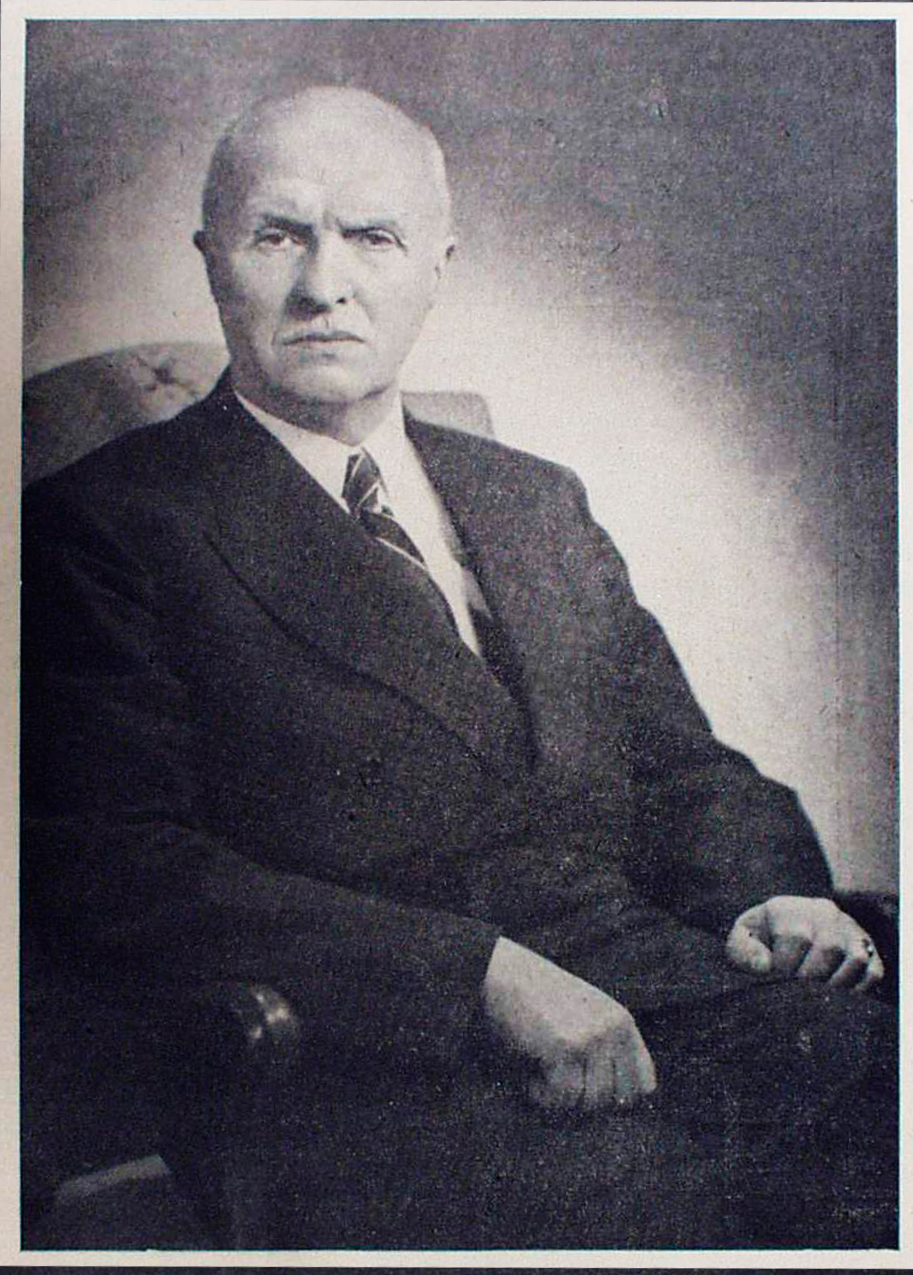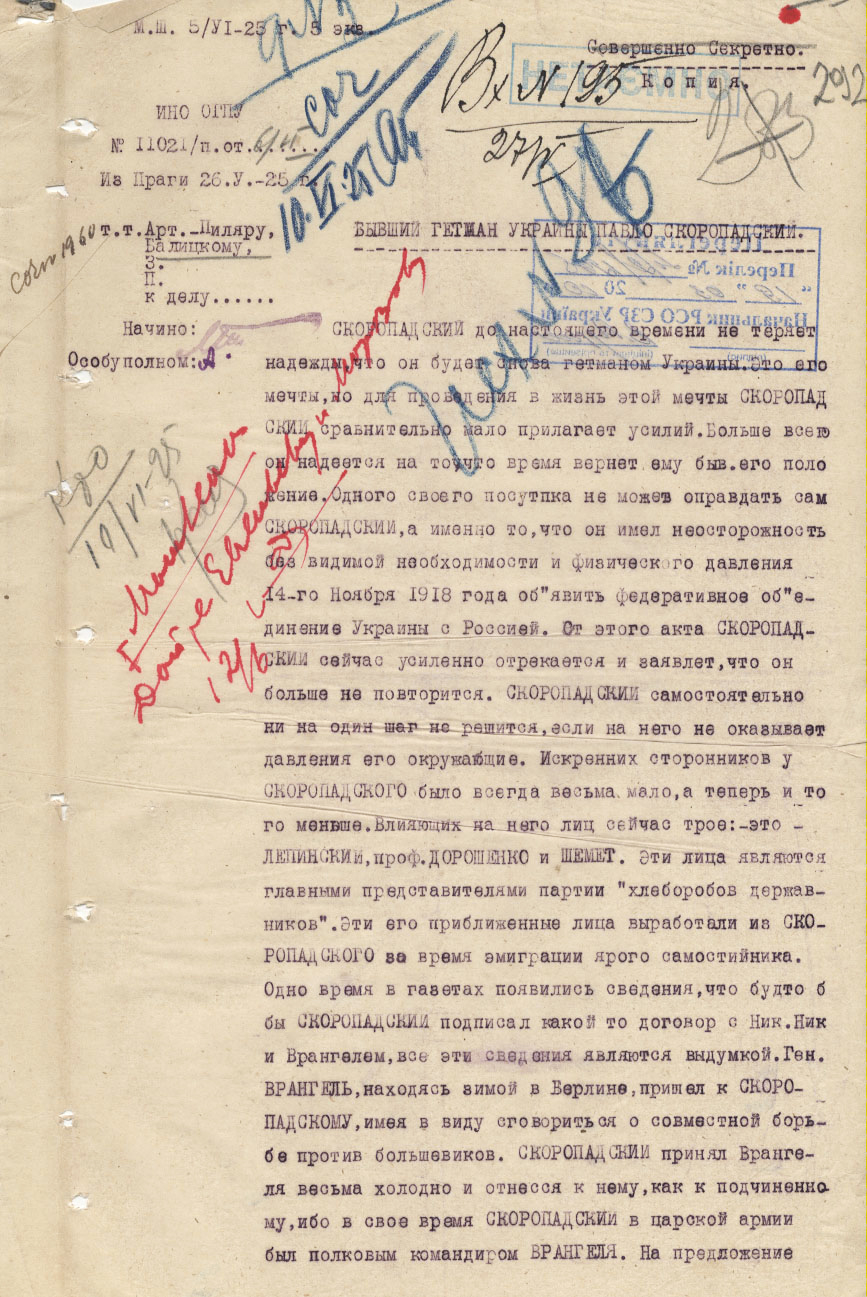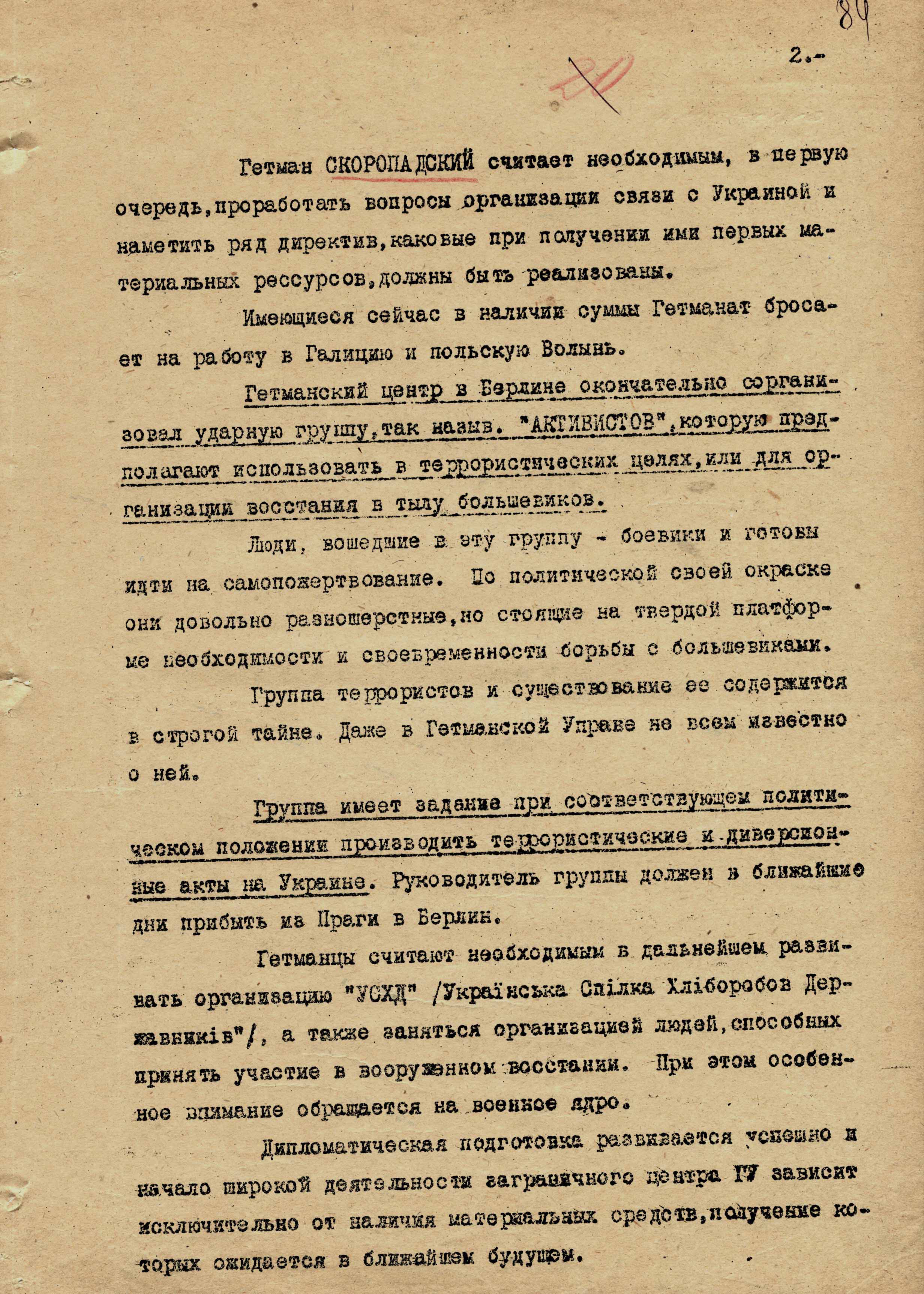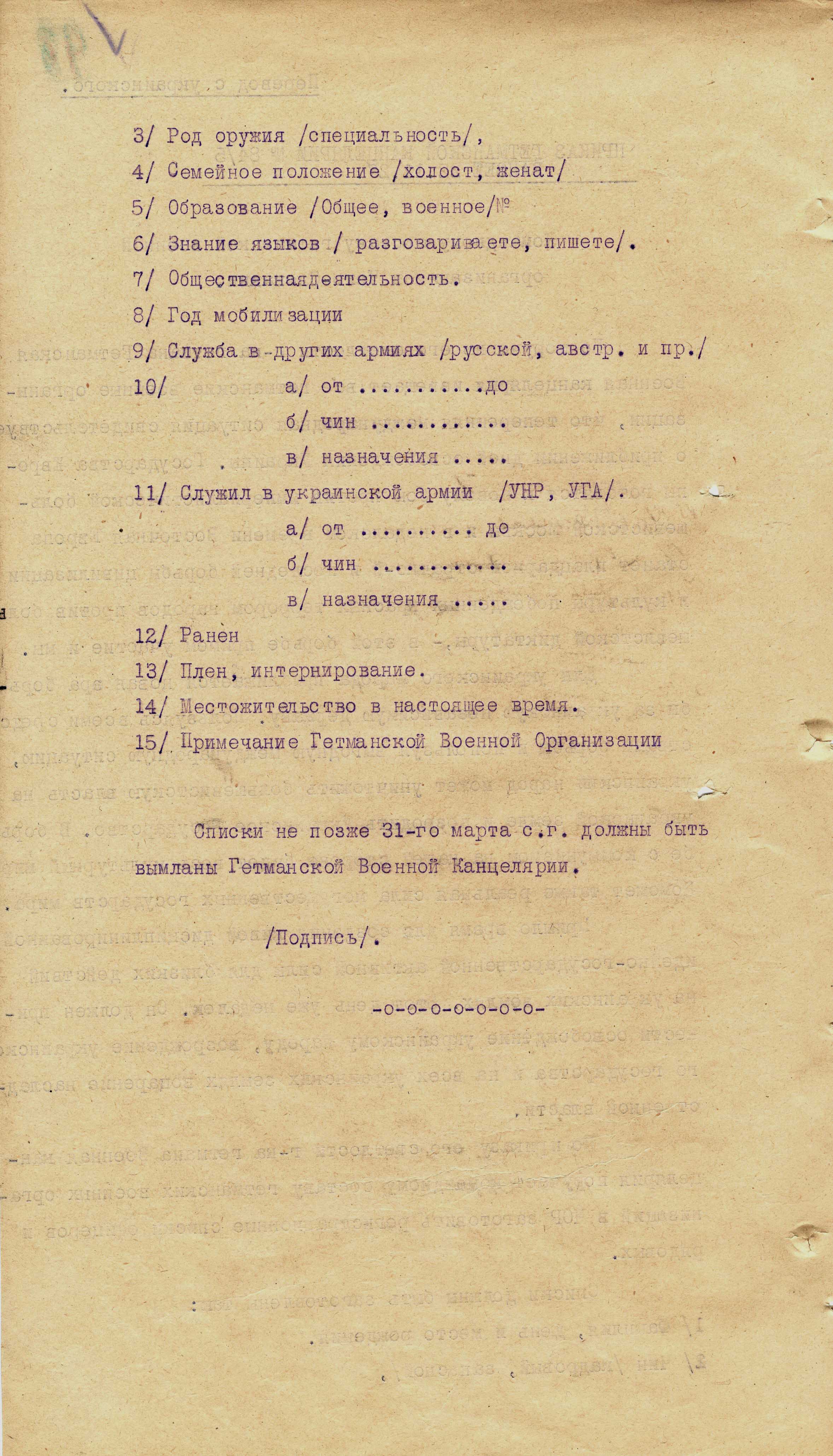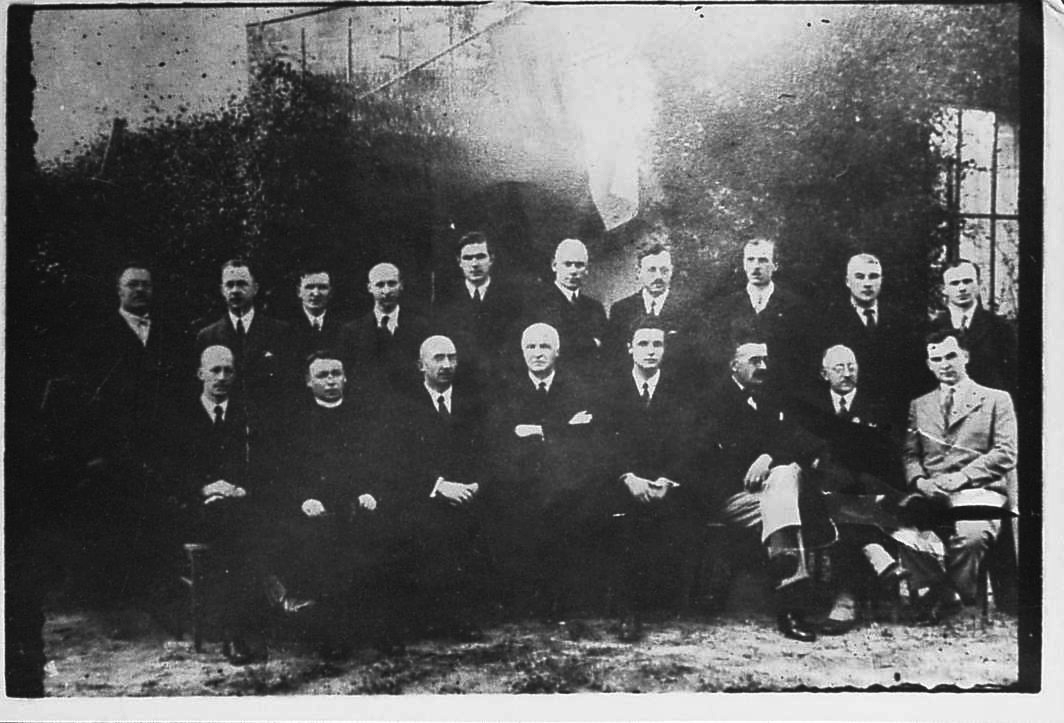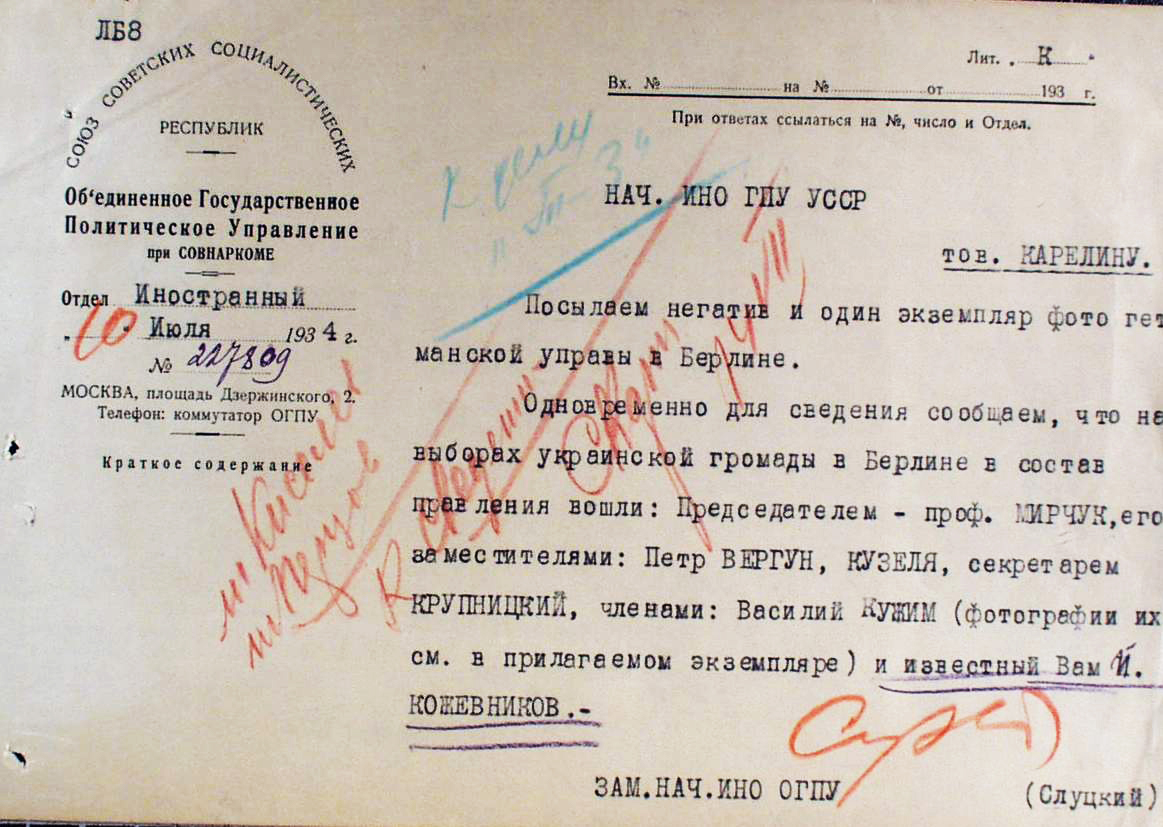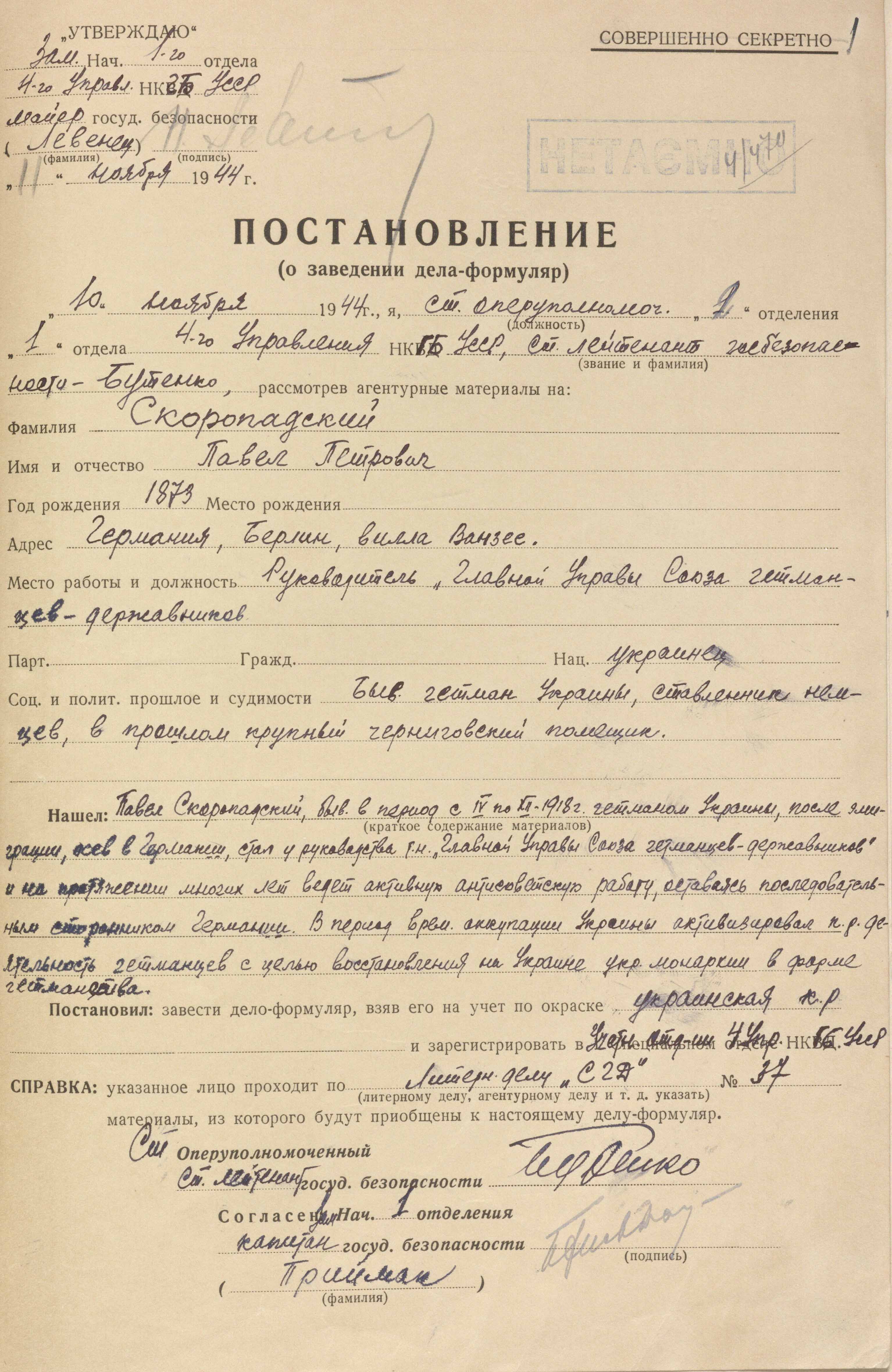Pavlo Skoropadskyi. In the Zone of Special Attention of the NKVD
5/15/2023
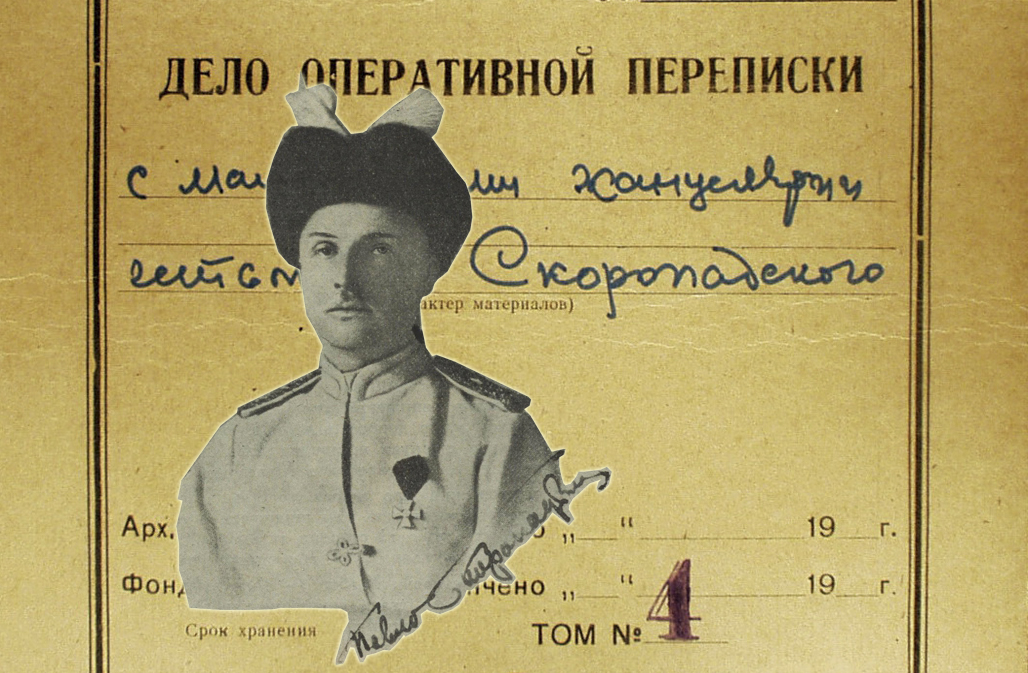
Through an in-depth study of the archives of the Foreign Intelligence Service of Ukraine, documents have been found that reveal new pages from the life and work of Hetman of Ukraine Pavlo Skoropadskyi and testify to the degree of Soviet special services’ (GPU, NKVD, NKGB in 1920s- 1940s) interest to his person and the Hetmanite movement in exile in general in 1920–1940. Along with the materials previously declassified and published by the SZRU, this makes it possible on the eve of P. Skoropadskyi’s 150th birthday, marked on May 15, to understand why he posed such a danger to the moscow bolshevik authorities.
What has been found in the Intelligence’s archives?
One summer day in 1945, employees of the operational sector of Berlin, within the framework of working out objects that could be of interest to the NKGB of the USSR, drove to the house where, according to the information they had, before the capitulation of Nazi Germany, had lived a supporter of former Hetman of Ukraine Pavlo Skoropadskyi, chief of the organizational department of Hetman's Administration Vasyl Murashko. They had information that documents on the activities of the Hetmanite movement in exile could be stored in the house.
The owner of the apartment was not at home. As it turned out, he broke with the Hetman and had long left the city. The door was opened by his wife Kateryna Murashko (according to archival documents, shortly thereafter she was arrested and placed in the USSR MGB’s special camp No. 7 in Germany). The search gave the expected result. Numerous documents carefully compiled in folders testified to the fact that they referred to the former Hetman and his relatives and associates. First, they came across the text of P. Skoropadsky's speech, delivered by him on January 1, 1943 on the anniversary of the founding of the Ukrainian Union of Farmers-Statesmen. Then – the reports on the work of branches of Hetmanite organizations in different regions, their structure, areas of activity, members. Most were letters.
In the report on the results of the search, officer of the 4th Department of the Operational Sector of Berlin, Major Korotya, pointed out as follows: “In 1945, by the Operational Sector of Berlin in Murashko’s apartment, where the office of the Ukrainian counterrevolutionary monarchist organization Hromada was located before the capitulation of Germany, was found and seized Skoropadsky's personal correspondence, which, after processing, was systematized in three folders”(BSA of the SZR of Ukraine. – F. 1. – Case 7242. – V. 1. – P. 407).
Besides, NKGB officers found a lot of materials of the Hetman's Administration in the process of developing the archives of the Ministry of the Interior of Germany. Initially, they were taken to Moscow, and in 1946-1947 this documentary complex was transferred to the MGB of the Ukrainian SSR.
In 2009, the Foreign Intelligence Service of Ukraine, after sorting out, declassifying and digitizing, provided electronic copies and several originals of these documents to the Ukrainian Institute of National Remembrance and the Museum of Hetmanship. These are 2247 documents on 4215 sheets, arranged in 19 volumes. Most of the documents are dated 1935-1939. Most of them are personal correspondence between Hetman Pavlo Skoropadskyi and his son Danylo, who, while traveling around the world, tried to unite as many people as possible around the idea of the Ukrainian liberation movement and find political partners. In letters, the son constantly informed his father about the current state of affairs of the Union of Hetman Statesmen and spoke about events in the world. Among other things, correspondence with prominent figures of the Hetmanite movement, biographical materials and the organization of Hetmanites’ work in Europe, the USA and Canada.
In 2020, the Branch State Archives of the Foreign Intelligence Service of Ukraine prepared and published an electronic publication in three parts entitled “The Hetmanite Movement of the Last Century in the Intelligence’s Archival Documents”. It includes 253 documents dated 1920-1930, which were stored in 57 volumes of 15 archival files. These are other materials about P. Skoropadskyi and his family, individual figures of the Hetmanate, the Hetman’s Liberation Struggle Fund, organizational structure, functions and main directions of work of the Hetmanite movement.
They include originals and copies of orders, instructions, resolutions of meetings, letters, questionnaires, statements, explanatory notes, official publications of foreign countries and printed publications of Ukrainian émigré parties and groups, as well as images of seals, symbols, handwritten signatures of Hetmanite movement leaders, photographs, etc.
At that time, the main attention was paid to the fullest possible publication of materials found in archival funds on the activities of Hetmanites in exile. Now an attempt has been made to analyze how this information was obtained by the Chekists, how operational developments were conducted, how deeply they managed to infiltrate their agents into the environment of Pavlo Skoropadskyi and other figures of the Hetmanite movement, to find out what was of particular interest to them, what actions, plans, views and statements of the Hetman caused concern, whether they intended to track down and arrest him at the end of the Second World War, as they did with other prominent figures of the Ukrainian national liberation movement.
“Skoropadsky is now strenuously renouncing the act of Ukraine’s federal unification with Russia”
Among the first materials obtained by the Chekists abroad, which have survived and are attached to letter and agent files, of special interest is a document dated June 6, 1925, entitled “Former Hetman of Ukraine Pavlo Skoropadskyi”. According to the details on it, this message first came from the Prague residentura of the OGPU of the USSR to Moscow, and then, signed by the Chief of the Foreign Department (Russian: Иностранный отдел, INO) of the OGPU, it was sent to Chief of the Counterintelligence Department of the Secret Operational Directorate of the OGPU of the USSR Artur Artuzov, his Deputy Roman Pilyar and Head of the GPU of the Ukrainian SSR Vsevolod Balytskyi.
The paper stated that P. Skoropadskyi did not lose hope to become Hetman of Ukraine again and made certain efforts for this. It was noted that, among other things, he made adjustments to his activities, worked on mistakes. In particular, he still could not justify one of his deeds, “namely, that he had the temerity without obvious necessity and physical pressure to declare a federative unification of Ukraine with Russia on November 14, 1918. Skoropadskyi now strenuously renounces this act and declares that it will not happen again”.
Further, in the document, in continuation of this thesis, it is mentioned that once in the newspapers there were reports about P. Skoropadskyi's alleged signing of an agreement with Grand Duke Nikolai Nikolayevich, the then head of the Russian All-Millitary Union (Russian: Русский Обще-Воинский Союз, abbreviated РОВС, ROVS) and Baron Pyotr Wrangel. But all this is refuted and is called fiction.
“General Wrangel, – reads the paper, – during his stay in Berlin in winter, visited Skoropadskyi, intending to reach an agreement on a joint struggle against the Bolsheviks. Skoropadskyi received Wrangel rather coldly and treated him as a subordinate, because at one time Skoropadskyi was Wrangel's regimental commander in the tsarist army. To Wrangel's proposal for joint work, Skoropadskyi replied that he was fighting for Ukrainian independence, while Wrangel – for a united Russia, which should include Ukraine. Therefore, there can be nothing in common between these two aspirations. Wrangel left having not reached any agreement with Skoropadskyi” (BSA of the SZR of Ukraine. – F. 1. – Case 10122. – V. 13. – P. 292-293).
The events described in the document took place precisely after the completion by the OGPU of the main stages of the well-known operations “Trest” (“Trust”- Transl.) and “Sindikat- 2” (“Syndicate-2”- Transl.) regarding foreign centers of Russian emigration, in the planning and conduct of which were directly engaged A. Artuzov and R. Pilyar. Therefore, addressing the document to them shows that they were expected to make similar proposals to Pavlo Skoropadskyi and the Ukrainian Union of Farmers-Statesmen headed by him abroad, in particular, to lure him out from abroad, arrest and execute. But the study of archival materials showed that in this case the events unfolded according to a slightly different scenario.
“Although Skoropadskyi was compromised in the past, now he pursues a moderate policy”
The issue of the OGPU of the USSR’s operational studying of P. Skoropadskyi and the Hetmanite movement abroad was in general entrusted to the GPU of the Ukrainian SSR. But at that time, in 1924-1925, the Ukrainian GPU’s Foreign Department was still in its infancy – being small in number and taking its first steps. According to directives from Moscow, it mainly concentrated its efforts on Poland and Romania, where the UPR Government and the remnants of the Ukrainian Army found refuge. It was the UPR Government in exile and its structures that were of the greatest interest. Germany, where the former Hetman lived with his closest supporters, was still poorly covered by the agentura of the republican GPU.
Therefore, at the initial stage, information about the Hetmanite movement, which came from abroad through various channels and from different sources, was mostly general. It concentrated on numerous letter cases of emigrants. At that time a separate case was not opened against the former Hetman.
According to archival documents, the Chekists could not recruit any of the prominent and influential Hetmanites abroad. At the same time, they managed to infiltrate their agents into P. Skoropadskyi's close circle at different times. This made it possible to track almost all the processes that took place in the Hetmanite movement, but some things still remained out of reach. In this regard, one of the operational documents states that in the activities of the Hetman's Administration there is a strict conspiracy and adherence to the principle of “not to disclose (even to those close to them) anything that goes beyond their direct competence”.
In the second half of the 1920s, the Chekists collected information about P. Skoropadskyi’s attempts of rapprochement with the exile government of the UPR and their possible uniting in the struggle for an independent Ukraine. In particular, a paper of the INO of the GPU of the Ukrainian SSR dated April 13, 1926 mentions contacts between P. Skoropadskyi and S. Petliura, who allegedly “negotiate joint activities with the British on the issue of internal rebellion in the USSR and that they should receive funds from the British to support the uprisings”. It is further noted that serious steps have not yet been taken. Therefore, “so far it is only necessary to reckon with the fact that there is a union between Petliura and Skoropadskyi”(BSA of the SZR of Ukraine. – F. 1. – Case 10324. – V. 1. – P. 245).
These contacts did not develop, because a month and a half later S. Petliura, not without the possible participation of the Chekists, was killed in Paris. After his death, the situation in the circles of Ukrainian emigration in one of the documents of the GPU was characterized as follows:
“... News from the center of emigration showed that emigration in Prague, Germany, France and Romania raised the issue of recognizing the former Hetman Skoropadskyi as the leader.
By that time, the Petliura group had begun to fall apart. Some went to the Skoropadsky camp, which by that time had become stronger qualitatively and quantitatively. This group includes some Social Revolutionaries, right-wing Republicans and Independists.
Petliura’s prominent General Omelianovych-Pavlenko left the Petliurists in 1926 and joined the Hetmanite movement... Skoropadskyi appointed Pavlenko as his Commissioner on the territory of Czechoslovakia” (BSA of the SZR of Ukraine. – F. 1. – Case 7242. – V. 1. – P. 5 turn.)
Other documents of the INO of the GPU of the Ukrainian SSR, dated 1927-1928, state that at that time P. Skoropadskyi really made attempts to get closer to certain figures of the UPR, his local organizations carried out coordinated work with Petliurites, but this work was not advertised. It is noted that Hetmanites decided not to hinder the Petliurites in their aspirations to seize power in Ukraine through foreign intervention, and before that recommended their supporters to help them and act in concert. This information forced the GPU to more thoroughly collect information about P. Skoropadskyi’s activity and his intentions.
“Since 1928, when the study of Hetmanites abroad becomes systematic”, the Chekists wrote, “we have learnt more about the structure of the Hetman's organization and its leadership. These materials show that all activities of Hetmanites both abroad and on the territory of the Ukrainian SSR were led by Skoropadskyi and the so-called “Hetman's Uprava” (“Administration”- Transl.), which was located under the Hetman in the suburb of Berlin – Wannsee” (BSA of the SZR of Ukraine. – F. 1. – Case 7242. – V. 1. – P. 2).
The Chekists’ concern was caused, first of all, by P. Skoropadskyi’s very personality. In this regard, one of the reports of the INO of the OGPU of the USSR dated May 19, 1927 stated that after the murder of S. Petliura, the UPR could not nominate from its ranks a figure equal in authority to him. “A. Livytskyi can be a good minister”, the report says, “even a prime minister, but not a leader of the liberation movement. Skoropadskyi is a different thing – a representative of an ancient historic family; Skoropadskyi's personality itself has a solid specific weight, although Skoropadskyi was compromised in the past, but now he pursues a moderate policy, he educated himself and his family deeply in the Ukrainian spirit. Hetman Skoropadskyi is that sort of figure that will be followed not only by Germany, but by most European states”.(BSA of the SZR of Ukraine. – F. 1. – Case 7242. – V. 21. – P. 50).
Therefore, the INO OGPU received instructions to thoroughly collect any information about P. Skoropadskyi himself, about the structure of Hetmanite organizations, its leaders and active figures, all kinds of meetings and congresses. But of the greatest value for the GPU were Hetmanites’ military plans. This is reflected in a number of documents from that period. One of them, dated April 19, 1927, refers to the somehow received “Mr. Pasichnyk’s letter to the UNR Directory on Skoropadsky's military activities”. The letter notes that recently P. Skoropadskyi has launched extensive military-organizational activities in all centers of Ukrainian emigration. Further it describes a conference in Berlin with the participation of Hetmanites-Generals, which discussed strengthening and expanding existing military organizations in exile, as well as a special issue of organizing military units on the territory of Ukraine.
“According to the plan developed by Omelianovych-Pavlenko”, the document says, “the conference adopted a resolution on the establishment of a military organization in Ukraine. Besides, at Skoropadskyi’s suggestion, it was decided to organize Hetman's General Staff. Skoropadskyi appointed Omelianovych-Pavlenko as Chief of the General Staff (BSA of the SZR of Ukraine. – F. 1. – Case 12617. – V. 14. – P. 97).
The letter is accompanied by an order of the Hetman's office on the registration of all military supporters of the Hetmanate. It declares the following:
“The states of Europe are preparing for a new battle against imperialist bolshevik moscow, and soon Eastern Europe will become the springboard of the terrible and last struggle of civilization and culture of the peoples defeated by the red terror against the bolshevik dictatorship – we will also take part in this struggle.
For the Ukrainian people, a new era of struggle for the Ukrainian independent state is approaching. Using all means of struggle and using the advantageous international situation, Ukrainian people can destroy the bolshevik power on Ukrainian land and restore the Ukrainian State. In the fight against communism, the entire cultural world will be on our side. The real strength of the world powerful states will also help” (BSA of the SZR of Ukraine. – F. 1. – Case 12617. – V. 14. – P. 98).
The resolutions on the documents show that this was the information which forced the Chekists to engage more actively in dealing with the Hetmanate movement and its leader. One of the reports of the INO of the GPU of the Ukrainian SSR, dated August 27, 1928 and addressed to the intelligence and counterintelligence departments of the OGPU in Moscow with the remark “agent personal material, trustworthy”, referred to concrete steps taken by Hetmanites to achieve their plans.
The document pointed out that Pavlo Skoropadskyi had several conversations with the Reich President of Germany, Field Marshal Paul Hindenburg, who “supported Hetmanites financially as well”, about receiving funds and subsidies from German industrial circles and bankers. These funds were allegedly used to organize work on seeking and registering former Hetmanites in Ukraine, starting secret correspondence with them, establishing contacts with prominent Ukrainian scientists, representatives of the cultural and creative intelligentsia.
“In order to spread Hetman's ideas among proxies”, the document said, “Hetmanites send their literature to Ukraine, mainly to scientific institutions where there are persons with whom Hetmanites have agreed on this issue” (BSA of the SZR of Ukraine. – F. 1. – Case 12617. – V. 4. – Ark. 183-186).
“This movement poses a certain potential danger to the integrity of the Soviet Union”.
The most threatening information for the Chekists about the Hetmanites, which they received from abroad, was in the paper of the INO GPU USSR dated September 1, 1932. It was sent to all heads of departments of the GPU for further verification and taking urgent measures. Some phrases in the document are underlined to emphasize them – that the “Hetman's Center in Berlin has organized a strike group, the so-called “activists”, which they intend to use for terrorist purposes or to organize an uprising in the bolsheviks' rear”. It was reported that the persons included in the group are militants who are ready to make self-sacrifice, and that they stand firmly on the platform of “the need and timeliness of the struggle against the Bolsheviks”. It was noted that “the terrorist group and its existence is kept strictly secret. Even in the Hetman's Administration, not everyone knows about it” (BSA of the SZR of Ukraine. – F. 1. – Case 12617. – V. 10. – P. 83-84).
The persons mentioned in such documents were taken by the Chekists for operational verification. But after a detailed study and clarification of all the circumstances, they did not find either organized underground, or individual underground groups, or insurgent committees. Along with this, the GPU of the Ukrainian SSR tried to conduct operational games with the Hetman's Administration, like “Trest” and “Sindikat-2” (“Trust” and “Sindicate-2”- Transl.), carried out from moscow's standpoint, or the operation conventionally named “Tiutiun”, connected with the withdrawal to Ukrainian territory of General-Khorunzhyi Yurko Tiutiunnyk, his arrest, talking him into cooperation and, eventually, execution.
This operational game, which is mentioned in archival documents, lasted from about 1927 to 1935. According to the plan, the Chekists found a former Hetmanate figure in Ukraine, through whom they managed to bring in contact with P. Skoropadskyi and his close associates, first one, and later the second agent. They positioned themselves as supporters of the ideas of the Hetmanate. Several times they organized long trips to Berlin, where, according to a legend worked out by the GPU, they tried to convince Hetminites that they had created an extensive underground network in Ukraine. In particular, the Kharkiv, Poltava, Kherson, Lubensk, Kyiv communities, which were allegedly managed by the so-called “Kharkiv Center of Farmers-Statesmen”. To maintain the network, agents asked for money and periodically reported on the work done. One of them was even introduced to the jury of the Berlin Center of Hetman's Administration, the other participated in the Hetman's Congress in Berlin in 1930.
But the legendized organizations managed to record on their account only the issue of two leaflets and the holding of numerous secret meetings. This did not entirely satisfy the Berlin Center, which, in the absence of concrete actions, was in no hurry to allocate funds. Therefore, the NKVD (after the reorganization of the OGPU) came to the conclusion that the operation did not bring the desired results, and decided to stop it, concentrating efforts on counteracting foreign formations of the UPR, UVO, OUN. They were more radical and decisive in their plans and concrete steps, even had intelligence and counterintelligence units, a network of agents, residents, couriers, crossing points on the Polish-Ukrainian border, carried out specific reconnaissance activities on Ukrainian territory, actively collected the necessary information, and were engaged in the formation of real insurgent centres.
At the same time, the INO of the NKVD of the Ukrainian SSR did not ignore the Hetmanite movement and continued to promptly study it. Characteristic of this are the conclusions in one of the documents, which states that the patriarchal spirit reigns throughout the Hetman's organization, and only more progressive representatives of the movement rally around Hetman’s son Danylo. At this, attention is focused on the fact that P. Skoropadskyi and Hetman's Center “despite all their clumsiness and old-fashionedness, actually play a rather subtle game”. And the conclusion is: “This movement poses a certain potential danger to the integrity of the Soviet Union”.
These conclusions were supported by diverse information about the Hetmanites' extensive publishing and diplomatic activities, sending of Hetman's representatives to different countries, support and development of organizations in the USA, Canada, the Far East, contacts with the Vatican and tendencies towards rapprochement with influential figures in Germany and England. At the beginning of World War II, this was of particular concern to the Kremlin leadership.
Sergeant Vynnychenko against Lieutenant-General Skoropadskyi
The fact that the Chekists never stopped keeping P. Skoropadskyi in sight is evidenced by archival documents of the late 1930s – early 1940s. Among them, there are circulars from Moscow signed by the then Deputy Head of the 5th Department (Foreign Intelligence) of the GUGB NKVD USSR Pavel Sudoplatov. In particular, information about the former Hetman's trips in the spring of 1941 to a number of European cities, meetings with influential politicians and statesmen, and the growth of his activity.
In May 1941, the operative of the 1st Section of the 2nd Department of the 1st Directorate of the NKGB of the Ukrainian SSR, sergeant of state security Vynnychenko, having examined the available materials, came to the conclusion that P. Skoropadskyi was conducting active counterrevolutionary work against the Soviet Union. Therefore, he made a decision to start a form case against him.
With the outbreak of the German-Soviet war, collecting materials became more difficult. Only in 1944, with the entry of Soviet troops into the territory of Germany, operational work against the leaders of the Ukrainian national liberation movement resumed in full. As for some of them, in particular, S. Bandera, A. Melnyk, Y. Stetsko, O. Olzhych and others, as evidenced by the archives of the Intelligence, operations for their liquidation were planned at that time. On P. Skoropadskyi, on November 10, 1944, the NKGB of the Ukrainian SSR started a new case file. The resolution on it states that during the period of temporary occupation of Ukraine, he intensified the activities of the Hetmanites in order to restore in Ukraine a monarchy in the form of Hetmanate”.
Documents of that period show that P. Skoropadskyi finally abandoned the idea of Ukraine's federation with Russia. Among the archival materials, there is his speech at the II Delegate Congress of the Ukrainian community in Berlin (August 30, 1942). It contains the following words:
“...Is it necessary to finally abandon what the Ukrainian people have dreamed of for centuries? Should we forget the idea for which thousands and hundreds of thousands of Ukrainians gave away their lives? No, decidedly not!
... During its thousand-year history, the Ukrainian people experienced much worse times of its existence, but still remained a spiritually and physically healthy people.
... Under all circumstances, we will stand for the implementation of the Idea of our own Ukrainian State...
... We strive for our State, we strive for it because only in own State can people feel free, can become themselves, can develop a sense of respect for themselves in their citizens. Only own State can enable the people to fully develop all their talents and spiritual treasures. Finally, even materially, only own State can give its citizens the opportunity for a better material life...”(BSA of the SZR of Ukraine. – F. 1. – Case 7088. – V. 1. – P. 334_009–011).
Pavlo Skoropadskyi had no doubt about what would be done to him for such words in case of his falling into the hands of the NKGB. Indeed, he could have suffered the fate of Vasyl Vyshyvanyi, who on August 26, 1947, was kidnapped by SMERSH employees in the British zone of occupation of Vienna and soon placed in Lukyanivska prison, where he died. Therefore, at the end of the war, the former Hetman was doing his best not to get into the territory captured by Soviet troops, tried to move away from the front line. But in vain. On April 16, 1945, during the bombing of one of the railway stations near Munich by Anglo-American aviation, he was mortally wounded. He died on April 26, 1945 in the hospital of the Metten monastery. He missed his 78th birthday by one month.
